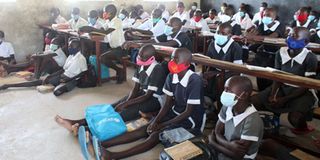Education must be open to all children

Pupils inside a classroom at Canaan Primary School on January 6, 2021.
What you need to know:
- Students are also dealing with several crises at home, such as abuse, underage pregnancies, deaths in the family and many others.
- This can manifest as poor grades, when in better circumstances, the student could very likely have performed better.
Kenyans have long placed value on educational prowess and achievement. The country celebrates with children who do well in national exams, and listens to their ambitions, collectively sending them good wishes.
Many Kenyans further help fundraising efforts in their circles, online or via media, to help students and their families meet the rising costs of education both locally and internationally.
We can expand our conversations about education nationally. A place to start can be the opportunities for bursaries only for limited numbers of marginalised, academically gifted people.
Article 43 of the Constitution gives all Kenyans a right to education, but this is not complete when those applying for limited bursaries have to expend so much energy and time in surmounting numerous obstacles.
Bursaries for some were always intended as a first step to opening up opportunities for many more, but the step has, unfortunately, paused there for too long a time. The fact that those living in poverty or those who are otherwise marginalised must wait to win the lottery of a few bursary opportunities, or earn public generosity, while those who are rich have continuous access to education despite their academic prowess, is far from ideal.
Deep systemic dysfunction
Students are also dealing with several crises at home, such as abuse, underage pregnancies, deaths in the family, and many others, which contribute to difficult academic journeys. This can manifest as poor grades, when in better circumstances, the student could very likely have performed better.
Kenyans who are limited by poor infrastructure should be considered too. We all recall media stories of children who row boats in crocodile-infested waters daily to school, and the teacher who walked upward of 20 kilometres to deliver national exams by hand.
It is high time the policy, regulatory and implementation gaps that Kenyan students and teachers face in education delivery are discussed. Over-reliance on a few bursaries for educational opportunities is a thin cover for general educational underinvestment, revealing that a critical mass of students is being left behind. This is then labelled as an unfortunate lack of scholastic aptitude, when the truth is that with holistic support, students could have very different, more successful outcomes.
We have long praised people for obstacle course heroics, when these barriers are actually symptoms of deep systemic dysfunction. Kenyan educational stakeholders and the state must be challenged to make sure education is truly open for all, not just those whose parents were lucky enough to be able to afford fees and uniform.
The buck should not stop at bursary opportunities for a few, who also have to work overly hard to achieve these. These problems should be made matters of the past, and so that they are not the reason for another generation of children to struggle in achieving the education they have an inalienable right to.
The writer is a policy analyst. [email protected]





